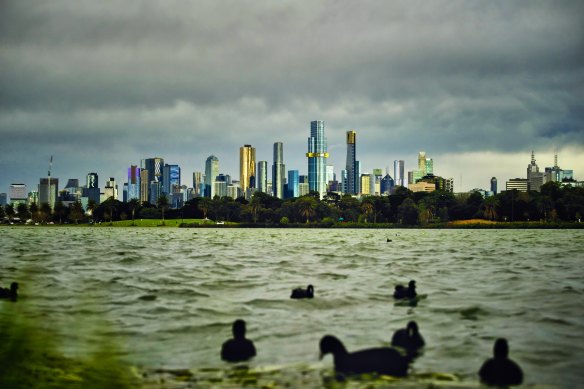Winter blues: Melbourne endures its darkest season yet
The unseasonably hot final weeks of 2024’s winter have sent national climate records tumbling, flowers in gardens into bloom and melted snow at ski resorts.
For Melbourne, Bureau of Meteorology figures show winter was warmer, wetter and darker than average.

Melburnians swimming in Albert Park Lake in August.Credit: Luis Enrique Ascui
Melburnians endured a 53-hour decrease in sunshine in June and July this year compared to 2023, with just 3½ hours of sunshine each day on average, compared with a long-term average of 4.1 hours in June and 4.4 hours in July.
In July 2023, the city basked in 153 hours of sunshine, with an average of five hours daily.
But as August ushered in an early spring, the city recorded a daily average of 5.9 hours of sunshine for the month, compared with a longer-term average of 5.4 hours a day.
Daytime and overnight temperatures for Melbourne were on average 3.2 degrees above long-term trends, as the city endured a winter of extremes.
Melbourne recorded an average daily maximum of 15.3 degrees for winter this year and an average maximum of 18.2 degrees this month, up to August 29. The previous August record average temperature was 17.7 degrees, so Melbourne is likely to have its warmest August on record.
In July, 72.6 millimetres of rain fell on the city; 54 per cent more than the long-term average of 47.1 millimetres.
Bureau of Meteorology senior climatologist Jonathan Pollock said Melbourne was drenched by the wettest July since 1996. July this year was in the wettest 10 per cent of all years since 1855.
This has been a winter of extremes. August’s unseasonably warm weather meant winter rainfall across the state was almost 40 per cent below average, and tracking as the driest Victorian winter since 2006, he said.
“Melbourne has been very dry in June and August [so far], but had above-average rainfall in July, particularly in the eastern suburbs and into Gippsland,” Pollock said.
The bureau’s outlook for spring suggests Victorian weather could be warmer than usual, with typical rainfall in most of the state.
Nationally, the hottest winter day was recorded this week, when Yampi Sound in the Kimberley region of Western Australia reached 41.6 degrees on Tuesday. London-based meteorologist Scott Duncan described this as an “astonishing intensity of heat for winter”.
The unseasonably warm weather and strong winds could be driven by the jet stream, which are powerful ribbons of strong winds high in the atmosphere that are currently snaking rapidly across the southern hemisphere from west to east.
Studies have found the jet stream is associated with an increased chance of heatwaves. A study in Nature Climate Change last year found the fastest upper-level jet stream winds will accelerate by about 2 per cent for every degree the world warms.
Several weeks ago a “polar vortex” brought freezing weather to eastern Australia, but the cold snap didn’t last long.
This was particularly stark in the Australian Alps, where it took until late July for decent snow cover and even then, it was patchy again by mid-August.
Sam Beaver, the policy lead at climate activist group Protect Our Winters and a research officer at the Australian National University, said the past few weeks of 10-degree days and strong winds had depleted the snow pack at most alpine resorts.
He said Mount Hotham fared better as one of the higher resorts, but had been hit with rain in the past week.
“We’ve had some good conditions, and we’ve we’ve had some really terrible conditions, but overall the trend is that we’re just seeing less snow and our winters shortening,” Beaver said.
Alpine Resorts Victoria is consulting on a climate adaptation strategy, which the agency hopes will help the sector survive and thrive even as the climate warms.
Emeritus Professor Lesley Hughes, from Macquarie University and also a founding councillor of the Climate Council, said this year’s winter had only a brief period of cold weather.
“We’ve had a short winter and a warm winter,” Hughes said. “The number of records broken this winter is an ominous warning.”
As well as the record in the Kimberley, Hughes said Roma in Queensland was 11 degrees above average for August, and Oodnadatta in South Australia was three degrees above average.
Hughes said almost every month in the past 12 months had broken that month’s hottest record since records began globally, in a “real upswing in escalating climate trends”.
Weatherzone meteorologist Ben Domensino said 2024 was on track to be Earth’s hottest year on record, beating the record set in 2023, even if a La Nina system formed and brought cooler weather later in the year.
Get to the heart of what’s happening with climate change and the environment. Our fortnightly Environment newsletter brings you the news, the issues and the solutions. Sign up here.